
views
Picking a Topic

Go over your assignment until you understand it. Read over the document, email, or message that describes the parameters of the report. From this read-through, try to get a sense of the report’s audience. Is only one person going to read it, like a professor or boss? Is it something that will be published on a wider level? Try to determine this until you fully understand what needs to be included in the report. For example, a book report or IT report will likely be read by just a professor or teacher, while a business report might be read by several individuals.Tip: Keep in mind that not all reports will necessarily be assigned. In the event of a car accident or random crime, you might have to report to your insurance company or fill out a police report. For these documents, try to approximate the likely audience of your report, like an officer or insurance agent.

Brainstorm the most effective points and arguments to include. Think about what the reader expects to get out of this report. Are they expecting a detailed analysis of a topic, or a brief overview of certain events? If you understand what the audience wants to read, then you’ll have a much easier time planning out your report. Unless you’ve been told otherwise, try to make your report as concise as possible. For instance, many reports are written to describe the results of a project or long-term assignment. In a report of those events, you only want to go over the highlights—not each and every detail of the project.

Outline different ideas before deciding on one that you like. Open up a new digital document or set aside a sheet of paper to begin planning the content of your report. Depending on the assignment, you might have some difficulty narrowing down an exact topic or focus for your final deliverable. In this case, start with one idea that you have and expand upon it an outline. If you’re having trouble coming up with general ideas for the topic, then there’s a good chance that your report should be heading in a different, more focused direction. For example, if you’re filling out a lab report, you’d want to include an introduction, apparatus, procedure, body, and conclusion section. If you’re having difficulty filling out each of these sections in detail, then you might want to re-evaluate your report’s content.
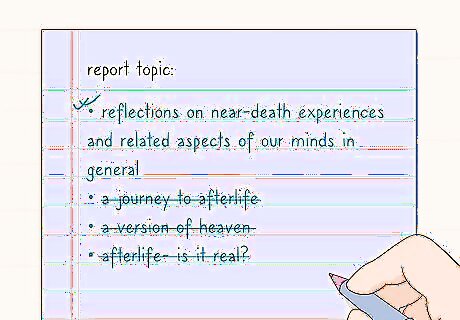
Choose a topic that is easy to research. In the event that you get the freedom to choose your exact topic, look into ideas that will be enjoyable and engaging to research. Search online or go to your local library to look up content that appeals to you, and see if you could expand upon any of those topics into your report. Above all else, make sure that you pick a topic that you won’t dread writing about. For example, if you have to write a book report, choose a book in a genre that interests you.
Finding Good Research Sources

Use databases to find credible content. If you aren’t using first hand research, or research that you’ve collected yourself, then you need to find reliable and credible second hand research. Search online to find free databases, which will lead you toward scholarly texts and journal articles. If you attend a university, ask a librarian to see if your school is subscribed to any paid databases. Use Google’s “scholar” feature to find credible sources on certain topics.

Go to your local library to look for helpful material. Log on to your local library’s website and see if they offer an online search tool for their catalog. Use general keywords when searching for materials—you might accidentally be skipping over great sources by being too specific. If you need any help, call your library for assistance. If you’re a student, take advantage of your school’s library.
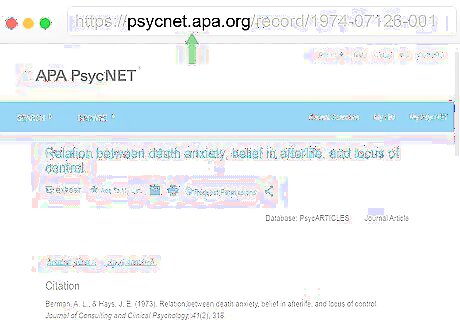
Examine the website’s domain name for validity. When using online sources, look at the web address to get an idea of what source you’re accessing. Keep in mind that “.edu” and “.gov” are likely to be reliable more consistently than a “.com” website. While “.org” websites can be great sources of information, be sure to check the domain before including it in a bibliography or works cited page. Overall, “.org” just indicates that the source is run by a nonprofit group. While there are many credible nonprofit groups out there, check to make sure that the website is founded in facts and credibility.

Duplicate your findings in another source. Continue searching in both print and online sources for an original piece of information. If you discovered your findings on your own, repeat the process until start to see patterns in the data you collect. Make sure that the information is credible before you include it in a report, as readers don’t want to be wasting their time with false facts. If you’re having difficulty finding a lot of sources for a certain topic, start with a crowd-sourced site like Wikipedia. While the information itself shouldn’t be used or referenced in a report, see if the site credits any reliable sources within the article.Tip: Try to look for academic sources that are peer-reviewed.

Look through a website’s design to see how it’s laid out. While you don’t want to judge a book by its cover, you can tell a lot about the quality of a source by how they present their information. Look for a sleek format with balanced colors, as well as a professional font. If the website looks like it hasn’t been updated in 15 years, then you might want to try looking elsewhere. Additionally, search for any spelling or grammatical errors in the text. You don’t want to reference information in your report that’s riddled with spelling mistakes.
Determining the Best Structure
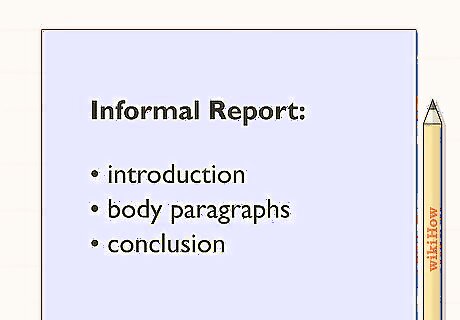
Opt for an informal report if you’re looking to present your info concisely. Break your information into clear groupings: introduction, body, and conclusion. Although different reports will require different kinds of sections, make sure that you have a clear section introducing the content, as well as a section that wraps up the information. If your professor or superior didn’t provide you with a rubric, look online for sample documents to get an idea of the proper formatting. Informal is an umbrella term used for a variety of different documents. Short memos, letter reports, and informal lab reports all fall under this category. For example, a short memo or letter report includes a heading, introductory statement, finding, and recommendation section.
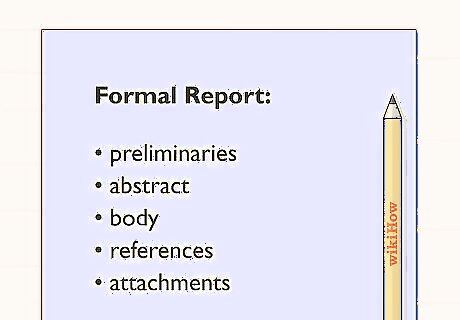
Choose a formal report if you’d like to include more detail. If you’re writing a more in-depth discussion of a topic, opt for a longer, more detailed document to present your information. In-depth reports can generally be divided into 5 major sections: preliminaries, abstract, body, references, and attachments. Use this format for a longer academic assignment, or any project that’s involved somewhat complicated data gathering. The preliminaries section refers to any content that appears at the beginning of the document. While this varies per assignment, some example preliminaries could include a letter of transmittal, acknowledgments, a table of contents, a title page, and/or a list of figures and tables.
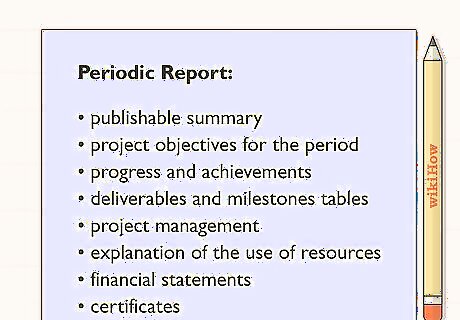
Write a periodic report if you’re reflecting on a shorter time period. Opt for this type of report when you’re looking to discuss many aspects of a certain amount of time, be they good or bad. When drafting this document, make sure that you include plenty of room for data results, like graphs. Use a format that best describes how the period of time that you’re discussing went. For instance, if you’re comparing the current period of time to a previous period, use a compare and contrast type of format to portray the differences between these 2 times. A self-evaluation at a university is a good example of this.
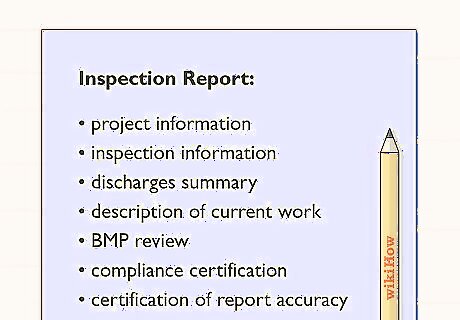
Go for an inspection report if you’re examining a structure in depth. When inspecting a building or other structure, make your findings as clear as possible by using a consistent, predetermined document. Depending on where you work or what you’re inspecting, there might already be inspection documents on hand; in this case, use whatever is already available. If there are no documents lying around, keep your report simple, concise, and understandable to whoever might be reading it. If you’re giving the report to a client, try to avoid using any fancy terminology that wouldn’t make sense to the average reader.
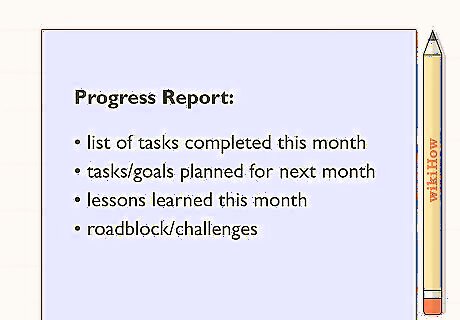
Draft a progress report if you’re discussing the future. Use a progress report to display how a group or corporation has done while going from point A to point B. While graphs and other visuals are very helpful in these reports, be sure to follow the structure and outline that you establish at the beginning of the document. In some cases, progress reports are easier to complete as a collaborative effort. For instance, you might have to fill out a progress report for a class to show how much you’ve completed in a cumulative project.
Outlining the Report

Explain your main purpose of the report in the thesis. Figure out the main point, or thesis, of your document and write in the first section of the outline. If you prefer to work sequentially, try creating an outline with Roman numerals and letters. In this case, your thesis would go with Roman numeral “I.” If you want to save room for the content of your introduction, use the letter “A” to create a sub point where you’d write out your thesis.
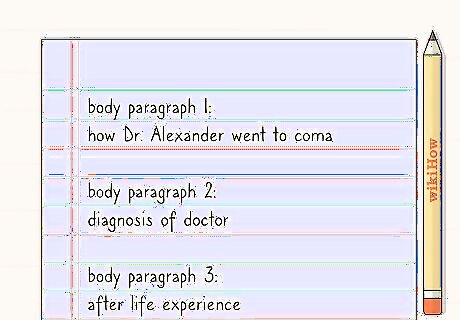
Sort through your main ideas and fit them into the outline’s structure. Use the report structure you decided on to format the rest of your report’s outline. Try to list the information in the same order that you want it to appear in the final draft of the document. If you’re planning on including any visuals, make a note of the graphs you plan on including in certain spots. These outlines will look very different depending on the structure. For instance, an outline for a scientific report would have separation sections/numerals for key graphs experimental design, as well as data exploration.

Include any supporting details as you think of them. Create sub points in the outline that involve extra evidence or sourcing for your ideas. If you’re using a book or journal source, make a rough note of the chapter and page number that you’re citing the information from, so it’ll be easier to fill out the bibliography later. If you flesh out more in your outline, then you’ll have an easier time later when you’re writing the report.

Figure out your introduction and conclusion at the end. Leave your introduction and conclusion sections blank until you’ve drafted out the rest of your main ideas in the outline. Once you have a better picture of how you plan on formatting your report, write out a sentence or 2 on how you plan on introducing and wrapping up a variety of topics. For instance, a sample introductory sentence on an outline could like: “Throughout the summer, a continued study showed that the placebo effect was 60% effective in curing symptoms of motion sickness.” It will be easier to write your introduction after you've done your research and have identified your thesis, since that is going to be your guiding idea.

Start fleshing your outline into a full report. Go section by section as you begin drafting your report. First, use the thesis you’ve written and place it at the end of your introductory paragraph. Build your first paragraph around this main purpose, and guide the reader through the main themes of the report. Continue this process, going through your outline and transferring the body and conclusion points into a draft. Work through one point at a time. If it helps, work through your report outline chronologically.

















Comments
0 comment